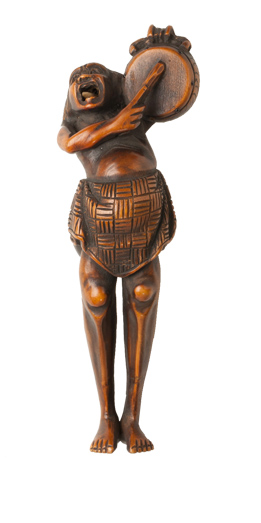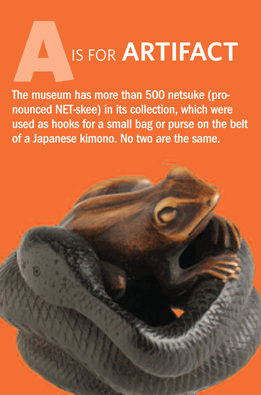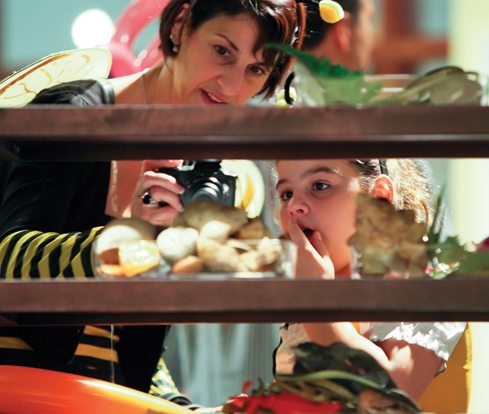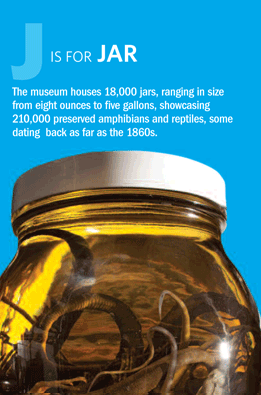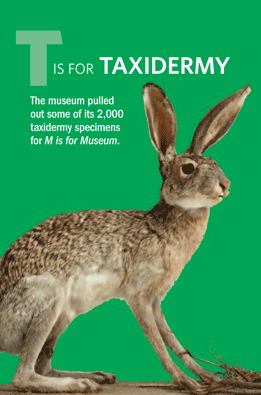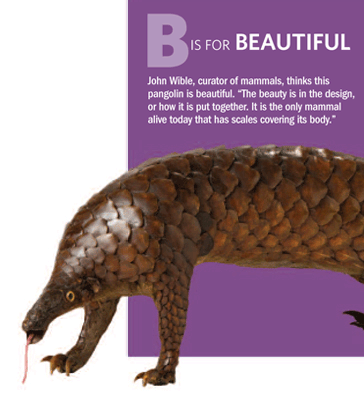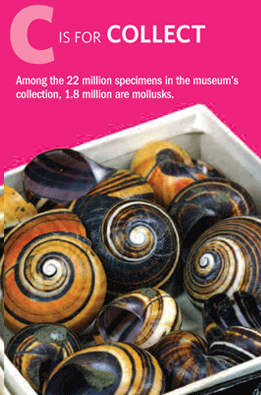 |
||||||||||||||
|
Photography by Josh Franzos |
The ABCs of Discovery
Carnegie Museum of Natural History’s M is for Museum is a wide-eyed, fun-filled look at how museum scientists are really kids at heart and every kid already has the heart of a scientific explorer.
Three-year-old Sylvie leans her back against the gallery wall and stretches her arms to her sides as far as they’ll reach. “Measure me!” she exhorts. “I’m SO big.” Compared to the ruby-throated hummingbird, whose four-inch wingspan is on the wall behind her in blue silhouette, she’s right. But Sylvie has nothing on the giant albatross, also depicted in silhouette. The wandering Antarctic sea bird, which can soar in the air for days without flapping its wings, has a wingspan of up to 12 feet.
In a nearby glass case, a hummingbird and a rare albatross from Carnegie Museum of Natural History’s collection of nearly 200,000 birds are on display, side by side, for the first time. It’s a powerful but simple lesson about the breathtaking diversity of the natural world that even a preschooler can grasp. That’s exactly the point of M is for Museum, Carnegie Museum of Natural History’s playful new exhibition about the goings-on at one of the world’s great natural history museums. On view through August in the third-floor R.P. Simmons Family Gallery, the 9,000-square-foot exhibition is sponsored in part by Baierl.com, Agora Cyber Charter School powered by K12, and Supercuts. As happens with preschoolers, Sylvie is suddenly distracted by a group of live winged creatures—well, actually, a swarm of laughing, running children decked out in costume bug and butterfly wings—and she opts to join them mid-flight. Together, they scurry past a floor-to- ceiling wall of giant mason jars filled with alcohol-preserved specimens of frogs, snakes, insects, birds, and mammals. They veer next towards another display case filled with hundreds of different beetle specimens in every imaginable size and color.
M is for Museum is meant to be a feast for the eyes, ears, hands, and feet—an interactive, multi-sensory learning adventure for kids like Sylvie, other curious young minds up to about age 13, and their favorite grown-ups. A chance to explore, unencumbered, the fascinating work of museum scientists, and become part of the never-ending thrill of discovery. A shell, a leaf, a frog, a rock. A bird, a bone, an egg, a tree. They’re all wondrous things, especially to children on a mission to figure out their world. But they’re wondrous, too, to the skilled researchers and scientists who make a living studying them. M is for Museum aims to be a bridge between those two schools of exploration. “The joy of discovery is every bit as great whether you are 70 or 7, a famous scientist or a curious preschooler,” says Sam Taylor, director of Carnegie Museum of Natural History.
B is for beauty all around us“Visitors come in and look at our dinosaurs every day,” Taylor says. “What they don’t realize is that assistant curator of vertebrate paleontology Matt Lamanna is in Antarctica finding the first dinosaurs ever discovered there. And scientists in our PaleoLab are preparing newly found skeletons from Argentina of the largest dinosaurs that ever roamed the planet. We want this exhibition to open young peoples’ eyes to the active research going on by our museum staff.”The museum also wants to remind its youngest visitors that they already possess the basic skills needed to do what museum scientists do every day. To look, listen, compare and identify, and collect and care for things they love.
“At school, children are students,” Taylor says, “but here, they are given permission to role play and actually envision themselves as scientists.” M is for Museum does all this by using the alphabet as a guide. Each letter is assigned a word corresponding to an important aspect of life at Carnegie Museum of Natural History, and each letter-word pairing has its own station. “The joy of discovery is every bit as great whether you are 70 or 7, a famous scientist or a curious preschooler.”
- Sam taylorIn “C is for Collect,” visitors are reminded that a key role of the museum is to collect and care for millions of specimens—a grand total of 22 million and counting—including the 3.5 million beetles that fill about 6,750 drawers. Thirty of those drawers have been pulled out and put on display in the exhibition. “A very small percentage of the millions of specimens here actually make it on the exhibit floor,” says Beth Redmond-Jones, an exhibition developer and project director for M is for Museum. “This was an exciting opportunity to show so many things the public has never seen before.”
“C is for Collect” also encourages young visitors to approach the world like scientists. They’re invited to sift though an area overflowing with toy plants and animals, rocks, shells, and other “specimens” to create their own collections for temporary display. The implied message here: Collect what you love. That’s exactly what the museum’s scientists have been doing for decades. In “B is for Beautiful,” the early loves that inspired the museum’s scientists, artists, and educators to do what they do are on poignant display. Paleontologist Matt Lamanna, who was just digging up dinosaurs in Antartica this summer, loaned a collection of children’s dinosaur books that he’d saved from his youth. “They may not look like much,” he says in the text of the accompanying label, “but to me they are beautiful because they sparked my love of dinosaurs.” Beneath a glass container that features the wildflower painted trillium, museum botanist Bonnie Isaac describes the roots of her professional passions: “Growing up, I always wanted to understand how everything around me fit into the environment. Painted trillium grows where I camped as a child. It is beautiful to me because it reminds me of camping with my dad and the curiosity about nature that made me want to work in the outdoors.” Museum director Taylor, who’s a marine biologist, showcases a seashell named spindle tibia, along with his thoughts on the beauty that inspired him: “A lifetime of scientific curiosity began in childhood with awe for beauty in nature,” he says. “This extraordinary seashell is a perfect example of how beauty can catch the eye, trigger the imagination, and generate endless questions. How does the shell form? Why is it shaped this way? Where does it live in nature?”
Please touchUnlike what traditionally happens at a natural history museum, M is for Museum is as much about doing as it is about looking. The gallery is a bright, comfortable space where children are free—and encouraged—to use their hands, noses, ears, and eyes to explore the wonder of the natural world. They can smell honeysuckle and lilac, listen to bird calls, and feel real wolverine pelts (claws included) and fake jackrabbit scat. In “P is for Powdermill Nature Reserve,” young visitors learn about the museum’s environmental research center in the Laurel Highlands, and can then step into the role of bird bander: They can remove a stuffed bird from a net, just as Powdermill’s bird banders do with the real thing, weigh it, place a band on its leg that will help track its migration, and then set it free. They can also make paper butterflies and add them to an already colorful collection on a neighboring butterfly wall. In “I is for Identify,” kids can choose from among six mammal skulls and then do what comes most naturally to kids these days: touch a screen on a computer, which then guides them through a process of elimination and, ultimately, identification. It could be a gray ox, a raccoon, or maybe a woodchuck. “We have really focused attention on younger children’s ways of learning,” says Mary Ann Steiner, director of the museum’s Center for Lifelong Science Learning and curator of public engagement. She adds that museum educators and volunteers, including its teen docents, will continuously staff the exhibition. Different elements of M is for Museum, which represents the first major project of the museum’s Center for Lifelong Science Learning, could have life beyond the exhibition. Center staff plan on working with the University of Pittsburgh’s Center for Learning in Out-of-School Environments to evaluate which stations in the exhibition are the most popular and effective. Those displays will then be installed in the permanent galleries. “M is for Museum is setting the bar for what we do next,” says Ellen McCallie, the museum’s deputy director. “The experience of this museum is changing; it’s transforming.”
And loosening up a little? “If you ask parents of young children about the museum, they’ll say it can be hard to visit because you can’t touch anything, you have to be quiet, and you can’t run,” says Taylor. “I’ll grant you, there’s not a whole lot you can touch here, but where does it say you can’t run and you have to be quiet? Those aren’t my rules. “Well, in M is for Museum, you can run, you can play, you can be very loud—and yes, you can touch!”
Additional support for M is for Museum was provided by The Grable Foundation, John E. and Sue M. Jackson Charitable Trust, Snee-Reinhardt Charitable Foundation, and two anonymous donors.
|
|||||||||||||
Photographing My People · International Negotiations · The Art of Reading a Face · Director's Note · NewsWorthy · Face Time: Linda Ortenzo · About Town: Game On · Artistic License: Contemporary Craft · The Big Picture
 |
Copyright © 2017 CARNEGIE Magazine. All rights reserved. |

